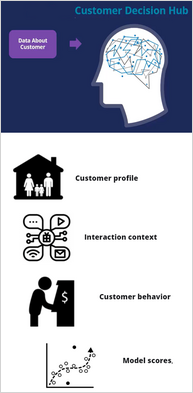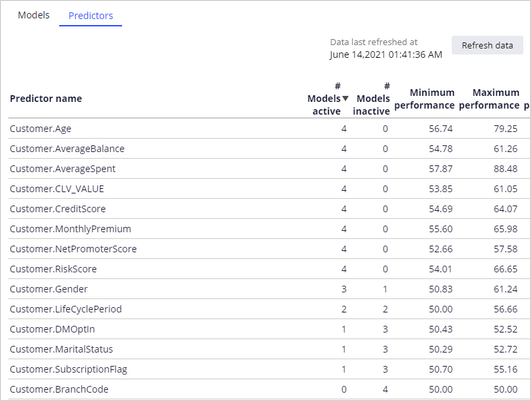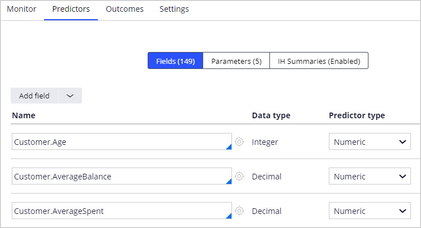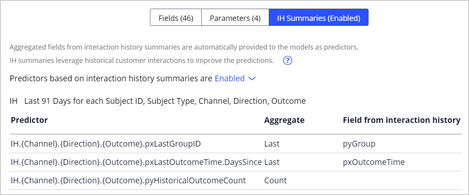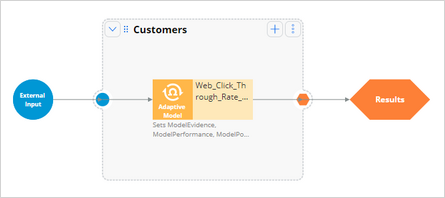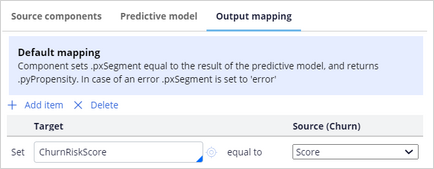
Creating parameterized predictors
Introduction
Learn how to improve the predictive power of your adaptive models by creating parameterized predictors. Input fields that are not directly available in the customer data model can be made accessible to the models by configuring these fields as parameterized predictors.
Video
Transcript
This demo shows you how to create parameterized predictors for adaptive models. U+ Bank shows personalized offers on their website when customers log in.
The bank relies on Pega Customer Decision Hub™ to decide which offer to show the customer. Customer Decision Hub uses a prediction to predict the likelihood that a customer clicks on the offer. The prediction ingests data about the customer to calculate the propensity. Ideally, this data includes the customer profile, interaction context, customer behavior and predictive model scores.
Customer Decision Hub weighs the propensity to decide which offer to show on the website, balancing customer relevance and business priority.
Input fields that are not directly available in the customer data model can be made accessible to the models by configuring these fields as parameterized predictors.
This video demonstrates the implementation of two new parameterized predictors that can add additional predictive power to the models. The first predictor is the ratio of customer visits to the Loans web page in the last 30 days and in the last 90 days. A high value may indicate the increasing interest of the customer in the content of this page.
The second predictor is the score of a churn model running in Customer Decision Hub. A customer that is likely to churn in the near future may be interested in different offers than a customer that is predicted to remain loyal. Managing predictions is a regular data scientist task.
The prediction that calculates the propensity that a customer will click on the offer on the U+ Bank website is the Predict Web Propensity prediction.
One or more predictive models drive a prediction. The Web Click Through Rate adaptive model drives the Predict Web Propensity prediction.
Adaptive models automatically determine which fields are used as predictors, based on the individual predictive performance and the correlation between active predictors.
Only fields with a predictive performance above the threshold become active predictors in one or more models. And, when predictors are highly correlated, they are grouped and only the best-performing predictor from the group is used. It is therefore a best practice to make many uncorrelated fields available to the models as potential predictors.
In an adaptive model rule, three distinct types of predictors can be defined.
The first predictor type concerns fields that contain customer attributes, such as age and average account balance, and customer behavior data summarized in Customer Profile Designer. The second predictor type is parameterized to reference attributes that are not part of the customer profile. Examples that can provide additional predictive power include derived fields, such as the time of day, and model scores. The third predictor type is an Interaction History summary, which leverages historical customer interactions.
This demo focuses on parameterized predictors.
For adaptive learning, there is no difference between parameterized predictors and regular predictors. To create a parameterized predictor, you add it in the adaptive model rule. In the example of Loans page views 30 days-to-90 days ratio, the data type is double.
A prediction is implemented as a decision strategy.
The decision strategy defines the control group and contains a sub strategy that references the adaptive model rule that drives the prediction, in this case the Web Click Through Rate model.
The values of parameterized predictors are set in the adaptive model component in the decision strategy.
The expression used for the new predictor says that if a customer has never visited the page in the last 90 days the value is set to zero, otherwise it is set to the number of visits in the last 30 days divided by the number of visits in the last 90 days.
When you add a parameter in the model rule, it automatically enables the field for input in the adaptive model component.
In the second use case, you want to include the score of a churn model running in Customer Decision Hub as a potential predictor. Just as in the first use case, start by adding the new parameter to the adaptive model.
For this use case, you need to alter the prediction decision strategy. To access the model scores, you add an external sub strategy that returns the score of a predictive model that calculates the churn risk of a customer.
Create a new sub strategy that references the churn model on the customer page and map the score of the model to a new property in the Strategy Result class.
The Score output field of the churn model is a numeric field with values from 0 to 1000. A high value indicates a high churn risk. You can now use this ChurnRiskScore property to populate the predictor in the adaptive model component in the decision strategy.
After refreshing the data, the two parameterized predictors are available to the models. They are currently inactive, but they will become active predictors over time, when they prove to have predictive power. The Churn model is now one of the supporting models in the prediction that calculates the likelihood that a customer clicks a specific offer.
You have reached the end of this demo. What did it show you?
How to create parameterized predictors.
Challenge
Tip: To practice what you have learned in this topic, consider taking the Creating parameterized predictors challenge.
This Topic is available in the following Modules:
If you are having problems with your training, please review the Pega Academy Support FAQs.
Want to help us improve this content?

